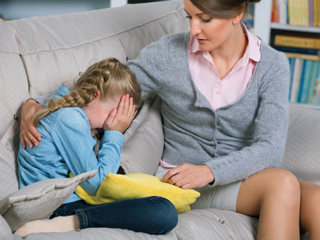The Healing Power of Touch, Part I
By Paul J. Ashton, Psy.D., D.Min.
Consultant to the VIRTUS® Programs
Lori Ricupito, Ph.D., CRC
Collaborator and Facilitator from the Diocese of Buffalo

When Jesus came down from the mountain, great crowds followed him. And then a leper approached, did him homage, and said, "Lord, if you wish, you can make me clean." He stretched out his hand, touched him, and said, "I will do it. Be made clean." His leprosy was cleansed immediately.
—Matthew 8: 1-3
From the moment of birth, to the final drawing of our last breath, the efficacy of human touch is a powerful and mighty force. Many studies cite healing, recovery and a reduction of pain, stress and anxiety because of the natural and non-judgmental touch from caring persons—loved ones and professionals alike.
The power of human touch is the force that propels the fundamentals of Christianity. Jesus, Himself, knew the power of His miraculous touch and we read many times in scripture of the simple, yet extraordinary ways in which He changed the lives of the people He touched—physically, emotionally and mentally.
One of the saddest parts of the problem of child sexual abuse and our response to eradicate it from our Church is that people are afraid to touch others even in a healthy, appropriate and holy way. We have heard over and over again from clergy and other ministers that they refuse to touch anyone for fear of being labeled or accused or even thought of as a person who would harm a child. How very sad.
Inappropriate touch is wrong. Appropriate touch is right under most circumstances. Knowing the balance and difference is the key. Depriving those whom we serve from our healing and affirming touch makes our ministry less effective—it is a sterile approach that is carefully planned, non-organic and thus appearing awkward and standoffish. At the same time we maintain the position that has been taught to thousands of participants in our Protecting God’s Children prevention program—there is no need to hug everyone all the time! Think about how you can use touch effectively when ministering to others. It can make a world of difference for a scared and crying six year old in religious education, an equally scared and aggravated sixteen year old in Confirmation class and a more fearful senior who is battling cancer in a hospice.
Many studies, including those by psychologist Conrad Baars, have found that appropriate, healthy touch is important in the growth and development of children. These studies have found that individuals who were deprived of healthy touch as babies and young children often have difficulties in developing positive interpersonal relationships throughout their lives. Children who have experienced a lack of affection may develop “reactive attachment disorder,” a childhood disorder indicating developmentally inappropriate ways of relating socially to others. Dr. Baars speaks in terms of “emotional deprivation.”
Many individuals who lacked positive physical touch and who experienced emotional rejection in early childhood grow up believing that they are incapable of loving others or God. They may doubt the sincerity of others, and believe that no one could possibly love them. They may have difficulty establishing healthy, mature relationships with others. This emotional isolation can lead to depression.
It is important to consider that not all touch is negative. Most of us are truly concerned for children and their welfare and our touches are not intended for self-affirmation or for grooming. In Part II of this article we will examine the differences between appropriate and inappropriate touch. In this first part we have seen that appropriately “touching in children is not only healthy but necessary to establish a bond, and secure an emotional peace.” PEACE AND HEALING
This article is not part of your continuing training. To access your required bulletins you must log in using the form in the upper left-hand corner of the screen. Then go to the TRAINING tab.



